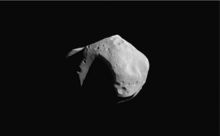Solar System/Asteroids
Location in the Solar System
[edit | edit source]
Conventionally asteroids are divided into three groups based on location.
Asteroids in the asteroid belt
[edit | edit source]The asteroid belt is located between Mars and Jupiter.
Jupiter trojans
[edit | edit source]Jupiter trojans share Jupiter's orbit around the Sun, and are located about 60° ahead of or behind Jupiter in their orbits.
Near-Earth objects
[edit | edit source]Near-Earth objects are asteroids that spend at least part of their orbit closer to the Sun than Mars. Their perihelia are less than 1.3 AU (Earth–Sun distances) from the Sun.
Centaurs
[edit | edit source]Centaurs are objects orbiting between the orbits of Jupiter and Neptune that cross the orbit of at least one gas giant. They have unstable orbits and have characteristics of both asteroids and comets. They are sometimes classified as asteroids.
Physical characteristics
[edit | edit source]"Families"
[edit | edit source]Mass, density, rotation
[edit | edit source]Composition
[edit | edit source]Chemical variations
[edit | edit source]Orbital features
[edit | edit source]Size
[edit | edit source]the sizes of asteroids may vary. some are huge and some may be as tiny as a speck of dust.
"Life span" of the asteroids
[edit | edit source]Ceres
[edit | edit source]Ceres is the largest asteroid, and in fact is a dwarf planet. See Ceres in the section on dwarf planets.